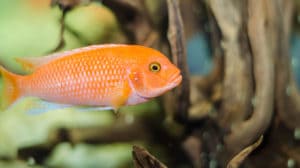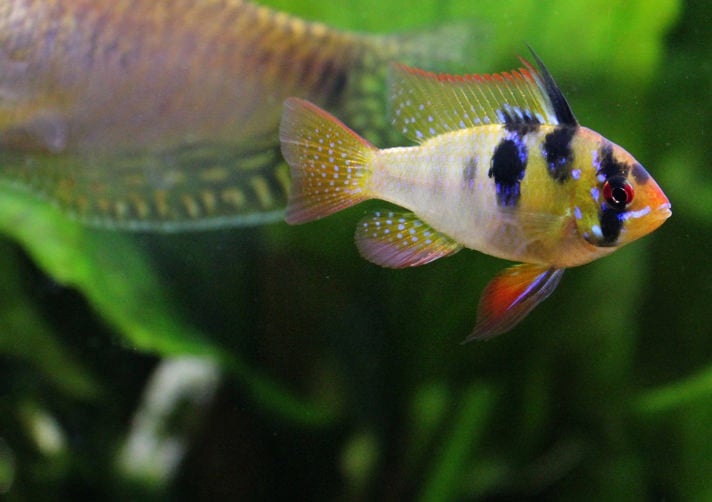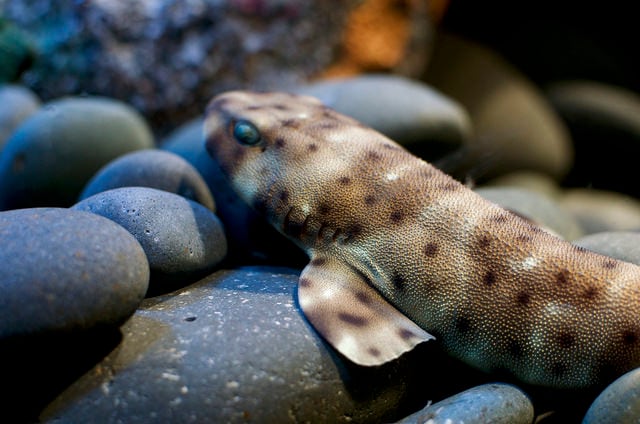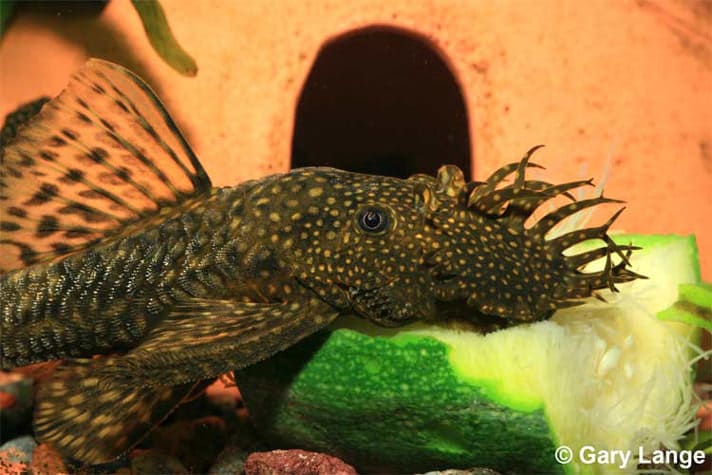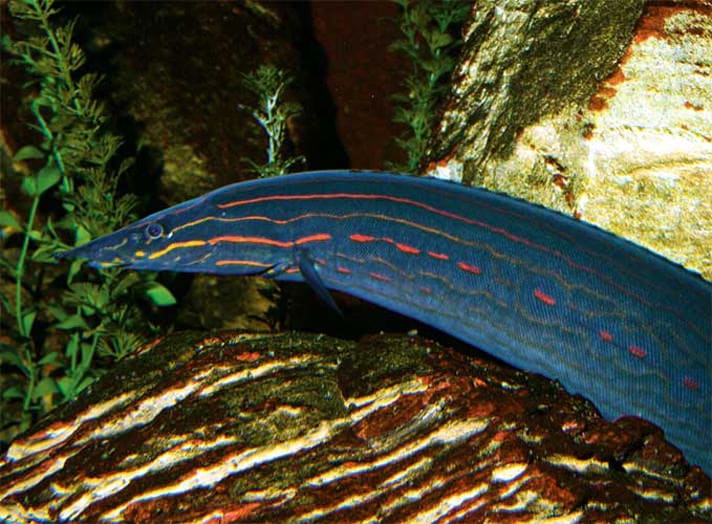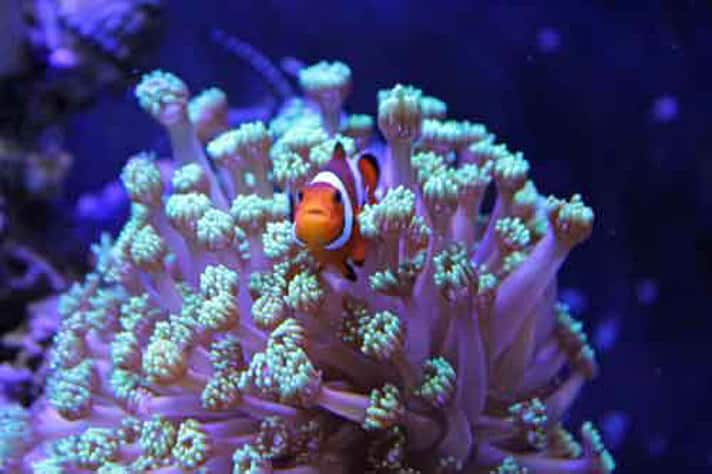As an aquarist of some long standing (many, many years), there have always been cichlid fish in my aquariums. And, while I have a hard time explaining to non-fish people the fascination of fish, I have no problem telling already initiated fish people (hobbyists) why I enjoy keeping cichlids. In one word: behavior. Members of the family Cichlidae are among the most “intelligent” and behaviorally advanced of our freshwater fish aquarium fishes. They hold and defend territories, and they go through elaborate courtship rituals and then guard and rear their eggs and offspring.
The downside of cichlid fish is that some of their behavior is not particularly conducive to a peaceful community aquarium. It’s not enough to claim and hold a territory — they must rearrange it to their liking. And, because other fish may have a difficult time escaping their territorial defense in the small closed system that is our aquarium glass box, mayhem and death are often the results.
Yet, as I hope to demonstrate, special cichlid-oriented community aquariums are indeed possible with a little care as to their setup and tankmate choice. And, having accommodated their behavioral needs, cichlids present their owners with a rich repertory of behavior not available from most other aquarium fish. I view cichlid fish as the “thinking person’s” tropical fish: aesthetics with a behavioral twist.
I’m here to say cichlids have taken a bad rap for all these many years. Yes, they are territorial and often aggressive, and yes, they can spell trouble in a community aquarium, but I like to think of them as wonderfully intelligent and interesting fish with “special needs.” Once an aquarist is made aware of those needs and gives cichlid fish what they need, they will be rewarded with interesting and complex behaviors, particularly those related to breeding, the likes of which are unavailable with most other aquarium fish. As Braz Walker (1978) wrote in his beginner’s book All About Cichlids: “Because Cichlids are generally larger than most tropicals, are often territorial or even aggressive and show more individualism than most other freshwater tropicals, it is not surprising that keeping and breeding them effectively requires certain techniques and considerations.” I agree.
What I hope to do in the rest of this article is to suggest a strategy for maintaining cichlids in the home aquarium, particularly for beginners or non-cichlid fish specialists, so that everyone can enjoy and experience the “essence of cichlid.” Along the way I hope to bash or at least temper a few of the unfair myths associated with these marvelous aquarium fish.
What Is A Cichlid?
Most aquarists, even beginning aquarists with inexperienced eyes, can pick out generic cichlid fish (pronounced “sicklids”) in their dealers aquariums. They have a certain “look” about them, both in terms of shape and behavior. That is because all cichlids share a number of anatomical and behavioral traits that have placed them in the family Cichlidae of the order Perciformes, or “perchlike” fish. For starters, they are all freshwater fish, although they are rather tolerant of brackish water and have close saltwater fish relatives, in particular the damselfishes, the wrasses and the surfperches, which together with cichlid fish comprise the suborder Percoidei.
Cichlid fish also share several peculiarities of their anatomy, some easily visible and others not. These include several rather obscure specializations of the digestive system and of the inner ear that we aquarists can’t easily see, and one key innovation, again not obvious to the casual observer, which has made them wildly successful in exploiting a variety of freshwater environments. This is the pharyngeal jaw, an anatomical specialization shared with the other Percoidei.
So then how, as aquarists, can we recognize cichlid fish? As their placement in the order Perciformes suggests they are typically “perchlike” in general shape. Think sunfish or bass (neither of which, however, are cichlids) in shape and general appearance.
They are also easy to identify on the basis of behavior. All cichlid fish are parental — that is, they care for their eggs and young, which sets them apart from the majority of fishes. The details of this parental behavior vary from species to species. Some are pair-bonding substrate spawners, others are mouthbrooders. However, there are other behaviors associated with reproduction — courtship, territoriality — that are uniquely “cichlid.” Gill-flaring, lateral displays and jaw-locking are all part of the behavioral repertory. Additionally, cichlids seem highly intelligent and responsive to their environment in the aquarium, unlike tetras or minnows. In short, the complex behavior of cichlid fish is one of the principal attractions for keeping them in the home aquarium.
The Diversity Of Cichlids
The fact that all cichlids share these characters suggests something about their relatedness in a historical sense. That is, they most probably evolved from one or a few ancestral cichlid fish, relatives of the ancestral marine damselfishes or wrasses, which first invaded the continental freshwaters of the tropics. Most likely this occurred before the separation and drift of the South American and African continents, because cichlids are well represented in the rivers and lakes of both.
Cichlid fish have been quite successful in their invasion of tropical freshwaters. In all, some 1400 species have been recognized, formally described and named by ichthyologists. In fact, there may be nearly double the number of actual species, half as yet undescribed. Of the described cichlids, about 1100 are of African provenance, the bulk of them (around 1000 species) found in the six major African lakes. The remaining 100 species are found in the various river systems of that continent. With three or so species known from Asia (e.g., India and Sri Lanka) and about a dozen species from the island of Madagascar off the coast of Africa, that leaves about 300 species of American provenance. That’s a lot of cichlids! And many of these are currently available to aquarium hobbyists.
How can we account for their tremendous success? Most probably it was the evolution of the pharyngeal mill — “throat jaws,” boney plates with teeth positioned in the throat in addition to the regular jaws — mentioned above, which enabled cichlids to become so successful in exploiting a variety of ecological niches. Most cichlids can eat anything that is available, which is welcome in the aquarium. They are opportunistic feeders, but in the wild, when the competition for fish food gets tough, they can specialize on exotic food items because of their pharyngeal jaws. The result is that they have become diverse and adapted to most tropical freshwater habitats, and are third only to catfishes and characins (includes the tetras) in the sheer numbers of species.
They became diverse not only with regard to feeding specializations and overall shape and size, but also in terms of their reproductive behavior. Generally speaking, cichlid fish are parental — they take care of their eggs and newly hatched fry. The details of that care, however, differ from species to species. Some cichlids are monogamous, with both parents participating in the guarding and rearing of their offspring. Usually they choose a surface — a plant, rock or piece of wood — to hold their clutch of eggs, which becomes the focal point for territorial defense. Sometimes a single male will defend a larger territory and have a harem of several females, spawning with each in turn. Sometimes the egg-bearing substrate is movable — a leaf — and the parents tug the eggs to safety.
Other species are polygynous, with males holding territories and spawning with as many females as they can attract. Typically, these species are known as “immediate” mouthbrooders, with the female picking up the eggs as soon as they are fertilized and incubating them in her mouth until they are free-swimming. And there are species that form stable pairs and lay their eggs on a substrate and guard them for a few days, only to pick them up in their mouths for the final incubation (delayed mouthbrooding).
These variations on the theme of parental care have allowed cichlid fish to thrive and compete successfully with other fishes and to diversify rapidly. While the total number of eggs they produce may be small relative to other fishes (typically a few hundred — fewer in mouthbrooding species, more in larger non-mouthbrooding species), their investment in parental care ensures that a greater percentage of the offspring will actually have a chance to survive.
Cichlids In The Home Aquarium
It is diversity that has, in part, made cichlid fish so popular as aquarium residents. There are so many of them, and they come in all shapes, sizes and colors. And, of course, there is the fascination of cichlid behavior! Early in the history of the aquarium hobby (around 1900) there was a very short list of New World cichlids being kept. The chanchito (“Cichlasoma” facetum) was the first of these, along with the port cichlid fish (Cichlasoma portalegrense) and the Brazilian pearl eartheater (Geophagus brasiliensis).
Subsequently, a growing list of cichlid fish from western Africa and the Americas made their way into the aquariums of fish fanciers. These included New World examples, like the convict cichlid, severum, freshwater angelfish and firemouth, and from Africa the jewelfish, kribensis and Egyptian mouthbrooder. All provided both color and interesting behaviors to aquarists of the early to mid-twentieth century.
Starting in the 1950s, but particularly the 1960s and ’70s, there was a gradual infusion of fantastically colored cichlids from the great rift lakes in Africa. First Lake Malawi (then called Lake Nyasa) yielded great cichlid treasures whose colors were as vibrant as those of marine reef fish. The cichlid boom was on! Following Lake Malawi came cichlid fish from Lake Tanganyika and Lake Victoria. Today, African rift lake cichlids are the most popular cichlid fish — and perhaps fish — in the aquarium hobby.
As importations from Africa rose, the variety of cichlids being collected and exported from South America and Central America, particularly in the 1980s and now the ’90s, also increased dramatically. “American” cichlids were more than just oscars and convicts, and today we are in the “golden age” of cichlids! Hundreds of cichlids, both New World and Old World, are available — both wild-caught and commercially bred specimens. There are literally cichlids for any aquarium situation — hard water or soft water, big aquariums or little aquariums, planted communities or rockwork aquariums. Everyone can experience the joy of raising and observing cichlid fish.
What Do Cichlids Need?
We need to start with some basic guidelines for cichlid captive husbandry. Cichlid fish are among the hardiest of aquarium fishes, and their basic care is quite simple. Nevertheless, peculiarities of their natural behaviors make keeping them a bit more problematic, and we must tailor their husbandry to fit their particular needs. This includes selecting and furnishing their aquariums, as well as certain approaches to maintaining water quality.
The average cichlid fish are moderate to large fish (between 4 to 12 inches in length, with exceptions above and below this) and fairly active. They have hearty appetites and are also messy feeders compared to, say, tetras. Although only rarely fish eaters, cichlid fish are opportunistic feeders and will take smaller fish if encountered. They — males in particular — defend territories both in the wild and in the aquarium, and can be quite aggressive in doing so. They often maintain these territories with established visual markers, and will dig pits, pull plants or move stones around to establish a focal point with good 360-degree visibility for that territory.
The male will hang in the center of that territory surveying the situation or displaying to females, or he will patrol its perimeter, foraging for fish food, maintaining the boundaries and defending it from intruders. Territory defense often consists of ritualized displays: gill and fin flaring to offer the largest, most threatening body “size” possible (frontal and lateral displays), and, if these don’t work at intimidating the competition, cichlids will resort to out-and-out fish aggression. In the wild, subordinate fish, usually the intruder, will simply be chased from the territory.
Below are the behavioral traits — peculiarly cichlid fish — that we must cater to in the home aquarium, quite unlike those of tetras or gouramis, and these are the behavioral traits that have given cichlids such terrible reputation in the aquarium hobby literature. However, these are also the behavioral traits that endear cichlids to hobbyists. I’m going to suggest some simple strategies or approaches for dealing with each of these behavioral “shortcomings,” because the rewards of keeping cichlid fish are many. And along the way I hope to dispel some of the myths associated with cichlid keeping.
Cichlids Need Big Aquariums
Beginners typically start out with a 10-gallon aquarium. For most cichlid fish, this is a mistake! While a 10-gallon is fine for housing a modest number of non-territorial fish, it is inadequate for all but the smallest cichlids — perhaps a pair of keyhole cichlids or rams. What do I recommend? The biggest aquarium you can afford that will fit into your available space. More precisely, an aquarium with a large “footprint” (bottom surface area) that will allow for the establishment of multiple territories. A 20-gallon long is better than a 20-high and a 30-long is far superior to a 29-high.
Actually, none of these is optimal if you are keeping bigger cichlid fish. If you can afford it and if you have the room, I would consider a “breeder” 40- to 50-gallon aquarium (36 inches long by 18 inches wide) or a 60- to 80-gallon (48 inches long by 18 inches wide) as the best compromise between affordability, size and the space demands of maintaining several moderately sized cichlid fish. Of course, if your budget and space will permit, larger aquariums (125, 135, 150 gallons and up) will allow you to keep larger communities of bigger cichlids. Nevertheless, if you don’t have the room or the budget, dwarf cichlid fish can be kept in smaller aquariums and provide the exact same behavioral show in a smaller package.
While we’re talking aquariums, there is another aspect of cichlid fish husbandry that bears mention: where to put the aquarium. Cichlids are easily “spooked” and need an environment that is stable and secure. The first place to start creating that is by situating the aquarium appropriately. The generality of cichlids appreciate an aquarium placed in an area that does not receive heavy or constant traffic, or at least is not in the line of traffic.
The aquarium should have a background of some sort, black paint, cardboard or even decorative commercial backgrounds are fine, as long as there is something covering the back glass. Finally, always place the aquarium in a “high” place. It has been my experience that many cichlids do not like aquariums placed near the floor (on the bottom shelf of a stand). If you want to see your fish, place the aquarium at least 30 inches off the floor.
Cichlids Dig And Uproot Plants
Well, frankly, many do — it’s part of their territorial imperative to create a territory that is to their liking! So there are many considerations when “decorating” an aquarium for cichlid fish. Decisions on whether gravel and aquatic plants are possible or advisable hinge on the nature of the species you choose and the intention of your husbandry. If the intent is a nicely planted aquarium including cichlids, then the proper choice of fish and aquatic plants will make this possible. However, many of the larger species are prone to rearranging their environs and this must be taken into account when aquascaping the aquarium. You should accept it as part of normal cichlid behavior.
Do cichlids need a substrate in the first place? The answer, again, depends on the nature of the species you intend to keep. Many species, including dwarf cichlids, medium-size acaras and eartheaters prefer — even require — substrates. In the case of the former the substrate is to anchor the aquatic plants, and in the case of the latter, to encourage normal “sifting” activity. In African rift lake cichlid fish, carbonate-rich substrates, such as dolomite or crushed coral, help buffer the water and contribute to the elevated carbonate hardness these fish prefer. But, they can all be raised in bare aquariums as well.
Given that most cichlids dig, are aquatic plants appropriate in the cichlid aquarium? Once again, that depends. There is no question that the generality of cichlids appreciate shelter of some sort. However, there is also no question that most cichlid fish are relatively intolerant of rooted plants given their predilection for digging and rearranging their “territories.” Moreover, some of them are partially herbivorous in the wild and will eat aquarium plants if given the opportunity. A decision to plant or not depends on the type of cichlids you are keeping.
If your intent is to keep dwarf cichlids or certain medium-size cichlids in a community situation, then aquatic plants are certainly appropriate — even advised. These are typically shy, retiring fish that require the security of shelter, both planted and other. Moreover, smaller cichlids are usually not inclined to dig excessively and uproot the aquatic plants. Indeed, if you want to keep cichlid fish in planted community aquariums, I recommend keeping dwarf cichlid fish. Even so, you should keep any large rooted plants you intend to use, such as Amazon swords, Aponogeton or Cryptocoryne, in clay or plastic flowerpots with some larger-size gravel. Then sink the potted plant into the aquarium substrate. This makes it easy to move the aquatic plant if necessary and keeps it from being uprooted, particularly with the larger pebbles on the surface.
Another solution is to use aquatic plants that do not require rooting, such as Java fern (Microsorium pteropus). Java fern has rhizoids, not roots (although they look like roots), and does not need to be planted to flourish. They can either be left floating or can be attached with a rubber band or nylon fishing line to driftwood, where they will eventually attach. Not only is this a beautiful plant, but apparently durable: most cichlids will not rip them up.
Another good choice is Java moss (Vesicularia dubyana), which will also attach to driftwood, and the old standby, water sprite (Ceratopteris thalictroides), which, although plantable, is better used as a floating plant. Water sprite grows fast and covers the surface, cutting down on the intense surface illumination — again, useful in making cichlid fish feel more secure.
For those with a black thumb or who want the appearance of a natural biotope while keeping large, plant-hating cichlids, there are always plastic plants. Modern plastic plants are quite realistic and obviously immune to destruction. Uprooting is another matter, but fastening them to stones with rubber bands will do the trick. In addition to aesthetics, plastic plants provide shelter, something that is essential for maintaining cichlids.
Cichlids Fight Constantly
Well, yes, cichlid fish can be belligerent, and usually this has to do with their normal territorial behavior. With any luck, you’ve already made an accommodation for this behavior by choosing a larger aquarium with a big footprint so there is room for a group to coexist. Nevertheless, a pecking order will become established, with dominant fish — usually males — running the show. Also, ripe males can spell death for females not yet ready to spawn, so shelter must be offered.
In the wild, subordinate fish (smaller males, females) simply swim away from the belligerent territorial fish. In the confines of the aquarium, particularly smaller aquariums, they may not be able to avoid the dominant fish, so they need some shelter to duck into as needed. This shelter can take many forms. As mentioned, live or plastic plants can be a helpful, as well as an aesthetic, solution. Driftwood or bog wood is also effective — and equally aesthetic by providing a focal-point for the aquarium — and when large or numerous enough, offers hiding space. Bog wood (and driftwood) has the additional advantage of leaching various natural organic chemicals (humic and tannic acids) that slowly turn the aquarium water a tea color, which is actually favorable for “blackwater” species from South America.
Other possibilities include rocks (slate, shale, quartz are all good, but no limestone unless you are keeping Central American or African rift lake cichlid fish), hollowed-out coconut shells, clay flowerpots (either upended or on their sides), commercial ceramic shelters (e.g., hollow “logs,” etc.) or plastic PVC piping. The latter is simply lengths (4 to 8 inches) of appropriate diameter (3/4 to 8 inches) cut from the standard pipe lengths available at little cost from your local home improvement store. Strewn throughout the aquarium to create cichlid condos, PVC piping looks horrible, but it gets the job done. And that job is to provide hiding places as needed for subordinate fish.
The use of shelter cuts both ways. On the one hand, it provides subordinate fish hiding places to escape the aggression of dominant fish. On the other hand, it can also encourage such aggression by providing physical markers for territories. In certain circumstances, bare aquariums can be used to rear a group of normally highly aggressive fish together with minimal conflict.
Raising groups of similar-size fish in bare aquariums devoid of any territorial markers (i.e., shelter) does curb aggression. The reasoning is — and it works — that in a large crowd of fish, no one fish will suffer the repeated and directed aggression of the most dominant individual. Nor will that individual be able to establish and hold a territory, both because of the crowding and because there are no physical territorial markers over which to fight. The downside of this strategy is that particular care must be taken to make sure that water quality does not deteriorate in a crowded aquarium. However, this can be overcome by strict attention to maintenance.
Cichlids Can’t Be Kept In The Community Aquarium
Despite their reputation for aggression, there are many cichlid fish that can — and sometimes should — be kept in mixed community situations. These include the various dwarf cichlids, medium-size acaras and eartheaters, and some of the smaller cichlasomines, as well as most African rift lake species.
For smaller species, the community aquarium is the antidote to natural shyness. The strategy is known as “dither,” and is simple in conception and execution. By providing peaceful, schooling species, such as tetras, that are rarely intimidated, cichlid fish will become less shy. Dither fish species should be selected with an eye to the size of the cichlids they will live with and the conditions being offered.
For South American cichlids, typically kept at high temperatures (78 to 86 degrees Fahrenheit) in soft, acid-neutral water, larger tetras, silver dollars (Metynnis or Myleus species), elongate hatchetfish (Triportheus species) and other peaceful characoids fit the bill. For medium-size Central American or African rift lake cichlid fish kept in harder, more alkaline water, various Australian rainbowfish (Melanotaenia species) work well. All of these suggested dither fish are quick, top- to mid-water swimmers, and can usually dodge the cichlids that occupy the lower level of the aquarium. Obviously, it is important to use dither fish of a size that cannot be swallowed by the resident cichlid fish. This can be a problem for some of the “monsters” that are typically kept only with other cichlids.
Catfish certainly have their place in the cichlid fish aquarium. For South American cichlids, these include armored “cory” cats (Corydoras and Brochis species), their larger relatives (e.g., porthole cats, Dianema species), and the “hoplo” cats (Hoplosternum and Callichthys species). All of these are social fish that live in large schools in the wild — please keep groups rather than single fish! One caveat with respect to Corydoras species is that they are sometimes intolerant of higher temperatures (greater than 80 degrees).
Other choices include various small “talking” catfish like Raphael cats and their relatives (Doradidae) and smaller “pleco”-type suckermouth cats of the family Loricariidae, particularly clown (Peckoltia species) or bristlenose plecos (Ancistrus species). Many of the larger “pleco” species, while beautiful, can become somewhat aggressive and damage the cichlids! Always provide plecos with driftwood, which they require for proper digestion, and feed them directly with romaine lettuce, parboiled zucchini and Spirulina-based sinking pellets or disks. Catfish are “scavengers” in a sense, but they don’t live on fish waste! For African rift lake cichlid fish, many of the African Synodontis species (upside-down catfish types) work well, and I have even seen pleco-types prosper in an aquarium of these cichlids.
Of course, there are other possibilities. Experiment, but do so intelligently. For instance, other fish that look like cichlids in body shape and that occupy the bottom of the aquarium will probably run into trouble given the territoriality of cichlid fish. Also, fish from colder water, such as the various minnows (Cyprinidae) like barbs or danios (not really “tropical” species), probably won’t do well in the warmer cichlid fish aquarium. Take the time to read about the intended community residents before you buy on impulse. And remember, for the cichlid community the emphasis is on “cichlids” and their requirements — the rest of the community should be selected based on this reference point.
The “All-Cichlids” Community Aquarium
Some people are attracted to cichlid fish by the sheer majesty of their size, and many species do get big, with an attitude to match! They can be territorial with a vengeance, and spend their days digging and rearranging the aquarium when they are not threatening the fish next door. I must admit that there is a certain charm to these giants, and for them, an “all-cichlids” community is the way to go.
Obviously, if you are going to keep “monster” cichlid fish that grow to a foot or more, you’re going to need a large aquarium with both adequate gallonage and bottom area. I’d probably try this in an aquarium of at least 100 gallons, preferably larger, with a footprint of at least 6 feet by 18 inches. The aquarium will probably do better if the occupants are somewhat crowded, and if the aquarium is kept more-or-less bare (so there are not many potential territorial markers available). Also, be prepared to filter it heavily and to do regular, massive water changes — it can be a challenge to maintain water quality for a gaggle of heavy, sloppy eaters!
It also is not a bad idea to keep only single males. You should, of course, choose species with similar requirements and with similar temperament so they can “give” as good as they “get.” The idea is not to encourage fighting, but to discourage it — or rather, to limit the interactions to ritualized aggression without causing the scales to fly! If it sounds like an art, it is! It will take some experience to get the right mix of fish species, but a community of “tankbusters” is truly a sight to behold! It is the essence of “cichlid.”
For many African rift lake cichlid fish, particular the rock-dwelling mbuna from Lake Malawi, cichlid community aquariums are the preferable way to go! Lots of rocks (shelter) and lots of fish, with attention paid to the eventual adult size of the residents. Other considerations include not stocking with similar species (e.g., various peacock, Aulonocara species, or zebra, Pseudotropheus zebra, types) so as to avoid indiscriminate hybridizations, which will readily occur in the confines of the aquarium.
Also, as is true for New World cichlid fishs, some species are more aggressive than others and should not be added to the rift lake community. Again, reading one or more of the many excellent specialty texts on these fish (see bibliography) should go a long way toward narrowing your selection. This is a learning experience — experiment, but do so carefully.
Cichlids Are Difficult To Keep
This is another myth. In general, cichlid fish need warm, clean, well-oxygenated water. Water chemistry is less of a requirement. Although many beginning “general” aquarium guides and some of the classical texts recommend water temperatures around 75 degrees Fahrenheit, in fact, most cichlids prefer their water to be warmer — 78 to 84 degrees.
Community aquariums usually consist of a mixed bag of geographically unrelated fish species with varying temperature requirements. Most danios, for instance, live in cooler, fast-moving streams and prefer temperatures in the mid to high 60s, whereas tetras, like cichlids, come from more tropical waters with sustained temperatures in the 80s. Put them together and some compromise must be struck! It’s better, if you’re determined to keep cichlids, to give them what they need and select community tankmates accordingly.
At higher temperatures the amount of dissolved oxygen in the water decreases. This means that fish stocking densities must be lighter as the aquarium water temperature increases. It also means that heavy aeration — bubbling air through the water — is essential. Aeration is most simply provided through airstones or “airwands” driven by air pumps. This can be coupled to aquarium filtration by using submersible box filters instead of, or in addition to, airstones. Cichlids need lots of aeration.
Because cichlids have a wide distribution in nature, it follows that they have wide variation in water chemistry. What do we mean by water “chemistry?” Although there are many parameters of water chemistry, practically speaking for the aquarist, there are only two that matter: pH (acidity) and hardness. Some cichlids come from lakes and streams that are soft and acid, others from hard, alkaline waters.
In general, South American cichlid fish do better in neutral to mildly acid water (pH 6.5 to 7.2) of low to moderate hardness. Central American cichlids prefer neutral to mildly alkaline water (pH 7.0 to 8.2) of moderate hardness, and African rift lake cichlids flourish in decidedly hard, alkaline water (pH 8.0 to 9.0). Many captive-bred species of either provenance are more tolerant of pH than are their wild counterparts and will do well in “average” water (pH 7.0, moderate hardness). Optimally, you should provide water of a pH appropriate to the species you intend to keep.
It is a good idea to invest in pH an
Share:
